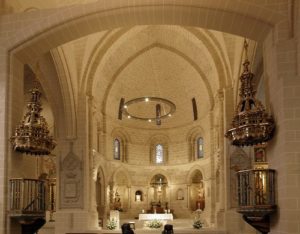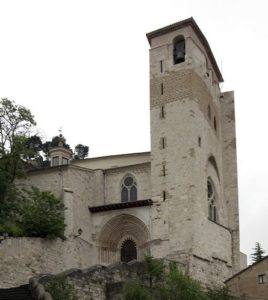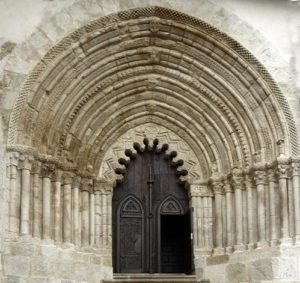Iglesia San Pedro de la Rua is is the largest church in Estella and is built on high ground across the river, overlooking the town. This was originally part of a 12thC monastery and is reached by a long flight of steps, although a lift is provided round the corner. We decided we needed the excerise.
It is a huge building with a massive nave. In comparison, the bell tower looks small. Entry is through the 13thC south door at the top of the steps. This has an elaborately carved wooden door surrounded by pillars and carved arches. The carving on the arches shows a strong Moorish influence. The inner arch is multi-lobed and has a Xhi-Rho sign in the centre. The capitals have carvings of griffons, two tailed mermaids and a centaur. The arches have flowers, swirling vegetation, stars, loops….
Steps lead into the church. By the door is a big carved 12thC font. On the base are four carved characters representing the four rivers that run through paradise. The carving on the bowl represents the tree of life. On the right is an elaborate gilt reredos. On the bottom is the Virgin Mary and Jesus holding out a rosary which is being grabbed by a monk. In the centre is a crowned Virgin holding the Christ Child. This is set in an arch surrounded by cherub heads and carved spiral gilt pillars. The portico above has cherubs holding a roundel containing a rosary. At the top is MAry being crowned by God.
Inside the nave on the north side is the Chapel of St Andrew, the patron saint of Estella, dated 1596. It has a locked metal grille across and contains a large Baroque reredos. In the centre under a cupola is a replica of the silver reliquary box which was stolen. Set in a gilded arch, it is surrounded by cherubs. On the walls are large oil paintings. The domed roof with a small lantern is painted in reds, blues and beiges. It is divided into segments which have pictures of scrolls and cherubs.
The altar in the north aisle has an image of the all seeing eye of God surrounded by a sunburst. The reredos has a 13thC crucifix in the centre surrounded by carved and gilded pillars. Above is a painting of St Michael killing the devil, represented by a dragon. Above is a Baroque painted dome.
In the nave are two massive pillars with carved capitals. One has a carving of St James as a pilgrim. Carved wooden steps on the pillars lead up to a pulpit or reading desk. Both have a carved sounding board above shaped like a crown. On the underside is a dove and a sunburst.
The ceiling is vaulted with a supporting stone truss. At the back of the church is a gallery. Beneath is a small organ, wooden confessional and old choir stalls round the walls. There is a painted crucifix with the two Marys.
Steps lead up to the large Romanesque east apse. This has an archway into the north chapel. There are four recessed arches with a statue of the Virgin with the Christ Child, Gothic crucifix, a 17thC St Peter wearing white, blue and pink Bishop’s robes with a crown and seated in a chair with cherub heads on the arm ends and St Andrew. In a smaller niche is a gilded host box. The three round topped windows contain modern stained glass.
The end of the south aisle has a gilded reredos with a carving of St Nicholas in red and gold robes and holding a bishop’s crook. He is set in a gilded arched frame and surrounded by gilded pillars. Above is an oil painting of Joseph holding the baby Jesus.
In a recess on the south wall is the tomb of the Dukes of Granada de Ega with three shields carved on the front. Small pillars with carved capitals support a carved round arch above the tomb. On the wall is a carved slab with a bishop’s head, On the walls round this are the remains of wall paintings.
On the south wall is a painting of someone holding the dead body of Christ set in a frame of gilded pillars. Above is a scallop shell with the head of a bishop in a carved portico topped by a cross.
A doorway in the north wall leads out to the 12thC cloisters. These have a blank wall facing the street and are entered through a wooden door. Only two walls of the cloisters survive with an arcade with round arches supported on double pillars. Each one has a different carving and many have biblical scenes. In the centre of the west wall are four pillars twisted round each other, a popular photo shot.
There are recessed niches in the north and east walls with carved round arches supported by round pillars with carved capitals. Several have pieces of carved masonry in them. The two niches on the west wall are larger and have a statue of St Peter holding the keys of Heaven and a bishop.
In the centre of the cloister is a fountain. On the south east corner is a small room. This has arcaded walls and a stone bench. There are good views of the outside of the church which is built of very pale stone with a pantiles roof. The east apse has carved corbels with faces.
We were delighted to find this church open as so many churches in Navarre are locked. It was, and still is, a popular stop on the pilgrim route to Santiago del Compostela. Many just take a photo as they plod on their way. Some actually climb up to the church and a few stop and pray. It is a fascinating church and well repays spending some time in, just looking.










